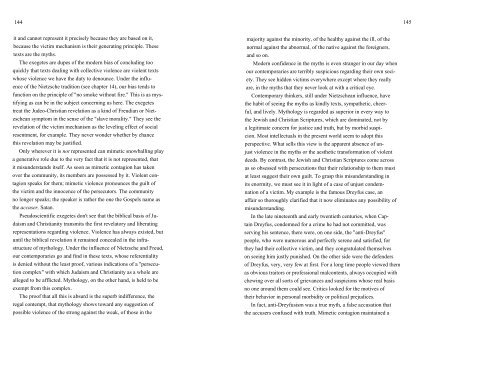I See Satan Fall Like Lightning
I See Satan Fall Like Lightning
I See Satan Fall Like Lightning
Create successful ePaper yourself
Turn your PDF publications into a flip-book with our unique Google optimized e-Paper software.
144 145<br />
it and cannot represent it precisely because they are based on it,<br />
because the victim mechanism is their generating principle. These<br />
texts are the myths.<br />
The exegetes are dupes of the modern bias of concluding too<br />
quickly that texts dealing with collective violence are violent texts<br />
whose violence we have the duty to denounce. Under the influ-<br />
ence of the Nietzsche tradition (see chapter 14), our bias tends to<br />
function on the principle of "no smoke without fire." This is as mys-<br />
tifying as can be in the subject concerning us here. The exegetes<br />
treat the Judeo-Christian revelation as a kind of Freudian or Niet-<br />
zschean symptom in the sense of the "slave morality." They see the<br />
revelation of the victim mechanism as the leveling effect of social<br />
resentment, for example. They never wonder whether by chance<br />
this revelation may be justified.<br />
Only wherever it is not represented can mimetic snowballing play<br />
a generative role due to the very fact that it is not represented, that<br />
it misunderstands itself. As soon as mimetic contagion has taken<br />
over the community, its members are possessed by it. Violent con-<br />
tagion speaks for them; mimetic violence pronounces the guilt of<br />
the victim and the innocence of the persecutors. The community<br />
no longer speaks; the speaker is rather the one the Gospels name as<br />
the accuser, <strong>Satan</strong>.<br />
Pseudoscientific exegetes don't see that the biblical basis of Ju-<br />
daism and Christianity transmits the first revelatory and liberating<br />
representations regarding violence. Violence has always existed, but<br />
until the biblical revelation it remained concealed in the infra-<br />
structure of mythology. Under the influence of Nietzsche and Freud,<br />
our contemporaries go and find in these texts, whose referentiality<br />
is denied without the least proof, various indications of a "persecu-<br />
tion complex" with which Judaism and Christianity as a whole are<br />
alleged to be afflicted. Mythology, on the other hand, is held to be<br />
exempt from this complex.<br />
The proof that all this is absurd is the superb indifference, the<br />
regal contempt, that mythology shows toward any suggestion of<br />
possible violence of the strong against the weak, of those in the<br />
majority against the minority, of the healthy against the ill, of the<br />
normal against the abnormal, of the native against the foreigners,<br />
and so on.<br />
Modern confidence in the myths is even stranger in our day when<br />
our contemporaries are terribly suspicious regarding their own soci-<br />
ety. They see hidden victims everywhere except where they really<br />
are, in the myths that they never look at with a critical eye.<br />
Contemporary thinkers, still under Nietzschean influence, have<br />
the habit of seeing the myths as kindly texts, sympathetic, cheer-<br />
ful, and lively. Mythology is regarded as superior in every way to<br />
the Jewish and Christian Scriptures, which are dominated, not by<br />
a legitimate concern for justice and truth, but by morbid suspi-<br />
cion. Most intellectuals in the present world seem to adopt this<br />
perspective. What sells this view is the apparent absence of un-<br />
just violence in the myths or the aesthetic transformation of violent<br />
deeds. By contrast, the Jewish and Christian Scriptures come across<br />
as so obsessed with persecutions that their relationship to them must<br />
at least suggest their own guilt. To grasp this misunderstanding in<br />
its enormity, we must see it in light of a case of unjust condem-<br />
nation of a victim. My example is the famous Dreyfus case, an<br />
affair so thoroughly clarified that it now eliminates any possibility of<br />
misunderstanding.<br />
In the late nineteenth and early twentieth centuries, when Cap-<br />
tain Dreyfus, condemned for a crime he had not committed, was<br />
serving his sentence, there were, on one side, the "anti-Dreyfus"<br />
people, who were numerous and perfectly serene and satisfied, for<br />
they had their collective victim, and they congratulated themselves<br />
on seeing him justly punished. On the other side were the defenders<br />
of Dreyfus, very, very few at first. For a long time people viewed them<br />
as obvious traitors or professional malcontents, always occupied with<br />
chewing over all sorts of grievances and suspicions whose real basis<br />
no one around them could see. Critics looked for the motives of<br />
their behavior in personal morbidity or political prejudices.<br />
In fact, anti-Dreyfusism was a true myth, a false accusation that<br />
the accusers confused with truth. Mimetic contagion maintained a
















